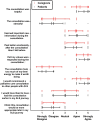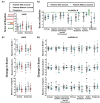Palliative care at any stage of amyotrophic lateral sclerosis: a prospective feasibility study
- PMID: 37780560
- PMCID: PMC10533918
- DOI: 10.3389/fmed.2023.1204816
Palliative care at any stage of amyotrophic lateral sclerosis: a prospective feasibility study
Abstract
Introduction: Many patients with amyotrophic lateral sclerosis (ALS) receive palliative care (PC) very late or not at all. The impact of PC on patients with ALS and caregivers has not been quantified. Study goals included (1) measuring the impact of early PC on quality of life and mood of patients/caregivers and (2) describing patient/caregiver satisfaction with PC.
Methods: The study was a non-randomized, prospective feasibility study of patients with ALS being treated at The Ottawa Hospital ALS Clinic and their caregivers. Exclusion criteria were age < 18 years, inability to complete questionnaires, and prior receipt of PC. The ALS Specific Quality of Life-Revised (ALSSQOL-R) questionnaire (patients only) and Hospital Anxiety and Depression Scale (HADS) were completed at regular intervals for up to 2 years. Patients accepting a PC consultation completed a post-PC satisfaction survey. Primary outcome measures included ALSSQOL-R and HADS scores compared before and after PC consultation, and between groups receiving and not receiving a PC consultation. Secondary outcome measures included responses on the post-PC satisfaction survey (1 = strongly disagree, 5 = strongly agree).
Results: 39 patients with ALS (age 66 ± 10 years, median time from diagnosis = 6 months) and 22 caregivers were enrolled. 32 patients had a PC consultation (30 were virtual). Patients and caregivers agreed with statements that the PC consult was helpful (mean ± SD = 4.54 ± 0.60, range = 3-5) and they would recommend PC to others with ALS (4.59 ± 0.59, range = 3-5). Participants disagreed with statements that the consult would have been better later in disease course (1.87 ± 0.80, range = 1-4) and that it took too much time/energy (1.44 ± 0.85, range = 1-4). Average ALSSQOL-R scores worsened significantly over time. HADS and ALSSQOL-R scores did not significantly differ between groups receiving and not receiving PC.
Conclusion: Patients with ALS and their caregivers found virtual PC consultations beneficial irrespective of disease duration or severity. Offering routine PC to all patients with ALS is feasible and should be considered as part of standard care.
Clinical trial registration: https://clinicaltrials.gov/ct2/show/NCT04257760, identifier NCT04257760.
Keywords: amyotrophic lateral scelerosis; anxiety; depression; palliative care; quality of life; virtual consultations.
Copyright © 2023 Zwicker, Smith, Rice, Murphy, Breiner, McNeely, Duff, Buenger, Zehrt, Nogo and Watt.
Conflict of interest statement
The authors declare that the research was conducted in the absence of any commercial or financial relationships that could be construed as a potential conflict of interest.
Figures





References
Associated data
LinkOut - more resources
Full Text Sources
Medical
Miscellaneous

